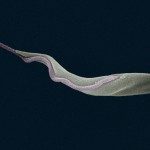Link to Pubmed [PMID] – 8658048
Scand. J. Immunol. 1996 Jun;43(6):604-12
The authors describe the immunological profile of BALB/c mice with Mite-Associated Ulcerative Dermatitis (MAUD)-like disease, due to Myocoptes musculinus (Koch 1844) infestation. The disease probably involves allergic mechanisms and is characterized by erythematous and pruritic skin lesions, widespread hair loss, lymphadenopathy, lymphocytopenia, granulocytosis and wasting. Affected individuals had much reduced numbers of pre-B and B cells in bone marrow and B cells in blood; decreased T-cell numbers in peripheral lymphoid organs and blood; hypergammaglobulinaemia with selective increases of IgG1, IgE and IgA, and depletion on IgM and IgG3, the same isotype distribution being detected in splenic plasmocytes; qualitative modifications of the serum antibody reactivity pattern; and increased production of IL-4 with decreased IL-2 production after in vitro polyclonal stimulation of T cells. Taken together, these results suggest that infestation by M. musculinus in BALB/c mice leads to a significant immunological disorder resulting in a T-helper-2 (Th-2) type response, with marked systemic consequences. This pathological condition may thus provide a useful model system for the immunobiological perturbation associated with chronic allergic disease.



